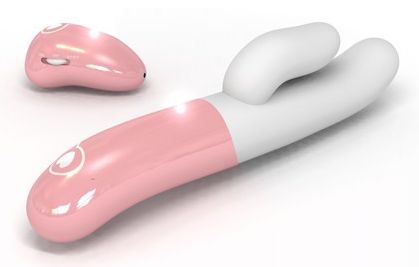Everything You Ever Wanted to Know About Modern Audio Toys
8 months in the making, it's finally here...
Thanks to the Walkman-esque personal audio revival brought on by the release of the iPod, audio vibrators seem to be the toy du jour. Audio triggered vibrators have existed for years, but until recently there'd only been one player in the field. Now there are 3 choices for your bass (or possibly treble) powered thumper, each providing a different experience in terms of both hardware and usability. In this article, we'll take a look at the hardware ideas behind audio vibrators, as well as the pros and cons of each product. We'll also end with a few ideas of what can be done with these vibes that no one seems to have picked up on yet.
The Very, Very Basics of Audio Triggering
(I'm totally glossing here. If you want the straight-forward, more correct version of this, read the wikipedia entries for Band Pass Filters and Low Pass Filters.)
You've probably seen what an audio waveform looks like before, but for those of you that haven't, here's one from a piece of audio I like to use for testing audio vibes, "Akku akku" by Acid Scout.
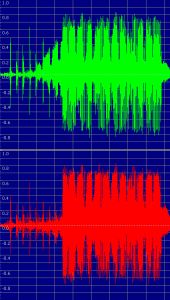
Clip of Acid Scout - Akku Akku (1:30, MP3)
As you can see, the waveform shows us the patterns in the song. We need to pick up the beat out of that and make our motor go with it. If we were using software and a nice processor, we could look ahead and come up with an accurate version using comb filters (mmm, DSP anyone?). But, since we're playing with toys, manufactured as cheaply as possible, we've gotta do this while the music is playing with no forward knowledge of what's coming up.
The most common way of doing this in hardware is what's known as a band pass filter. These consist of a tuned Resistor-Capacitor (RC) or Resistor-Inductor-Capacitor (RLC) network that only passes frequencies that fall in certain ranges through a circuit. Since most audio toys are interested in picking up the beat, which is a low frequency, we'll be talking about Low Pass Filters in this article.
A low pass filter can be, well, a lot of things. That wall between you and your neighbors blasting some sort of bass heavy music at 3am? That's a low pass filter! Notice that what's keeping you awake and calling the cops is just the low notes! Isn't science annoying?
Low pass filters only transmit a signal for the frequencies under a certain cutoff point. For our needs, we'll call this like, ~180-200hz. We can isolate the values in that range, and use that data (run through an amplifier, then ADC, then rectified and all sorts of other stuff that I'll post about in the "building your own" article) to control other functionality. Other filter setups can be used to pick up mid-high range values and react accordingly.
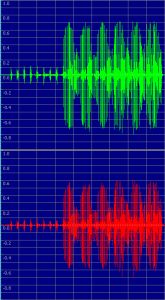
Clip of Acid Scout with 200hz LowPass - Akku Akku (1:30, MP3)
See/hear the difference? This is the data we want to pass to whatever is supposed to react to the music.
Anyways, this is how an audio vibe does what it does. Most audio vibes (I only own the OhMiBod and iBuzz) run band pass filters to ADC lines on their microcontroller (uC). The uC then samples the ADC lines as fast as possible and uses the delta between samples to scale the motor speed through PWM. If the incoming audio is stereo, the ADC values for both lines may be averaged on the chip to provide proper reaction values if the audio is right/left shifted.
Enough theory, let's talk implementation.
Audi-Oh
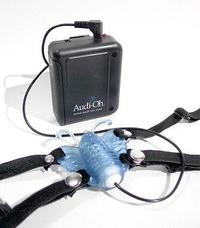
The Audi-Oh was the first major market audio trigger vibrator available. The company seems to have existed from the mid-90's up until sometime in 2005, when their website completely disappeared. No more information is known about them, at least, by me. You can still find them in random online sex toy stores, though. (If you happen to have one, please contact me through our tips at slashdong org email address.)
Ghett-Oh
The Ghett-Oh by Afrotech shows how easy it is to make an audio vibe. Of course, Afrotech was established on the idea that you could make a whole bunch of things from salvaged parts for really fuckin' cheap, so it's no surprise that all this involves is a CD-ROM drive and a soldering iron.
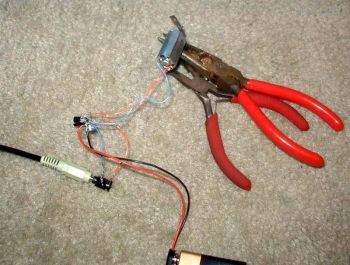
Remove the disc spinning motor, attach a weight, yank one of the transistors off the circuit board, solder it all to a battery pack properly, and you're ready to go. It's got that upstate prison flavor that'll keep you ugly all night long.
OhMiBod
(Opendildonics.org article on the OhMiBod, including pictures))
Now to the current commercial toys. First off, the OhMiBod by Suki Interactive. According to the press release, Suki was founded by a New England mother of two who wanted to make sex toys more accessible to the mainstream. Of course, this description has lodged in my mind alongside Suki from the Gilmore Girls, which makes either looking at this thing /or/ watching Gilmore Girls just plain wrong (though the current season of Gilmore Girls now far outweighs the wrongness it used to be up against. DAMN YOU, NEW WRITERS.).
OhMiBod Hardware - Eye on Marketing Version

The OhMiBod is a fairly standard hard plastic white vibe, the kind you'd find in most adult toy stores in even the most conservative parts of the nation that still sell these. Now, Good Vibrations and many other major toy stores have started making a majority of their stock ergonomic toys, however, when aiming for a toy with mainstream viability, you want to give people something they're comfortable with the idea of, even if the physical implementation leaves something to be desired. This is what the OhMiBod offers. The idea of having a toy with enough technology to react to music may cause people to feel uncomfortable, and handing them something with a "normal" footprint is a good way to get them sold in the first place.
No. NO. I am lying. I cannot continue writing this way. Let's try that again.
OhMiBod Hardware - Angry Engineer Version
The vibe itself is nothing special. It's your basic hard plastic, baseball bat pearl white vibe that looks as much like a bludgeoning tool as it does a pokey tool. You'd think with all of the modern amenities afforded to us by years of ergonomics research, you might want to use something with a few more curves to introduce the main stream to the world of the buzz-buzz, but why go out on a limb when you can reduce production costs, eh?
AND ANOTHER THING. While these types of vibes are... "acceptable" for front butt play, they fail miserably in one of my favorite areas of usage: in the butt. Yes, these suck for guys. I know. I'm a guy. As guys, we ain't got shit for toys due to lots of reasons, but there's issues of footprint of thrusting tools and then there's just outright fucking ignoring half the species. Yes, I have a hole, yes, it accommodates the general shape of the OhMiBod, but hell if I'm going to act like that's the only thing on the fucking market and use it.
(Note: So I was going to include some imagery here, but have you ever tried doing a google images search on "rectum" and "colon"? Wow. Damn. googlegoat.se)
Now I'm sure you're saying "qDot, can't you take it apart in that signature way that we know and love and read your ranting posts for?". Yes. Yes I could. But I shouldn't fucking have to. If you're going to specialize you vibrator to have interesting trigger features, with NO ergonomic specializations, then WTF are you thinking? "Let's make it suck for both sexes!"
Mmm. Ok. Much better. I need a cigarette after that.
OhMiBod Functionality
The OhMiBod function mechanism is held in the cap of the vibe. Change caps, and it changes function. The Audio Cap has a circuit board that you plug your audio line into, and the speed cap is a simple potentiometer based control that everyone knows and loves.
To change the intensity of the vibe, you raise or lower the volume of your music, which is in serial with the vibe processing. This, too, is fucking stupid, because it works with no processing to prevent clipping in the amplifier. Let's look at a graph of how the reaction level in a low pass filter works when volume is changed.
First off: Our first filtered waveform, just so you remember:

Think of the range of the y-axis on that being 8 bit, so between 0-255. That means, once you hit the top of the graph, the motor is going as fast as it can.
Now let's crank the volume by some unspecified amount so we can avoid math but still get the point across:

Notice how often we're above that line now. A lot. A whole lot. This is what is called "clipping". Now, this is not representing what is coming out of your headphones or speakers, this is what the chip is seeing. This may be what the perfect volume for listening for you looks like to the chip. It means that we'll have the motor on at full speed, all the time. There's no way for the processor to differentiate between low and high and whatever else because the base signal is overpowering the amplifier and the amplifier is all "OMGWTFBBQ" and the chip is all like "O RLY?" and the PWM is like "SRSLY 255" all the fucking time.
The way to alleviate this without building your own damn circuit is to get a headphone volume patch cable and put it between you and the audio in vibrator. That way you can act as a manual cutoff between the music and the vibe, and have the music at the volume you want while still getting proper reaction from the vibe. The fact that this isn't provided with the toy or just outright fixed is a serious oversight, though.
The OhMiBod Community
Seeing as the lovely people at OhMiBod were the first to send me free hardware for writing about them, I feel like I should leave a least a little positivity in this article, so I'll talk about their community. Building a community around your toy is a fucking fantastic idea, especially when you're aiming for a demographic that might be otherwise uncomfortable. It allows owners of the OhMiBod to recommend music to use with the vibe, as well as featuring mixes that accentuate
a certain mood. They also have DJ mixes available to accommodate play with the vibe.
Honestly, it's a decent idea, especially since it's set up by the distributor themselves. It lets people know that others like them use this type of product, and embarrassment is always one of the tougher parts of buying a toy.
iBuzz
(Opendildonics.org article on the IBuzz, including pictures))
Ah, the iBuzz. The second company to send me hardware for running this site. However, not only did they send me hardware, they sent me TWO iBuzzes: One for personal use, and ONE TO TAKE APART FOR THE SITE (which I did).
iBuzz people, you are my bestest friends evar.
iBuzz Hardware
Man, it's all about the 2.5mm jacks. If you read this site, you know how much I love them. They're like an open API for toy control (Ok, that's a really horrible analogy, but I figure it'll let some of you 2.0 kids out there understand this newfangled "hardware" stuff). I have eggs all over the place, and I have all sorts of toys that will drive them. Modularity kicks ass. Sure, they aren't ergonomic, but there's still a range of them to choose from. Just go check out the Blowfish.com bullet vibrator page to see.

Anyways, the iBuzz delivers on this end, much better than the OhMiBod. The iBuzz itself with a small white box with a switch (to change between modes) and a button (with LEDs! Blinky lights++!). The package size was reduced by 50% in the current version from the v1. Yay small!
In terms of jacks, you've got audio input, /dual/ audio output (No more losing that stupid splitter!), and single motor output. The toy comes with an interesting 2 way egg set, too. 2 eggs, one jack. So, you can share one iBuzz between two people, with two audio outputs and two eggs on the same box. Or you get double the fun yourself. And if you happen to lose the eggs at any point, you can easily replace them. Fucking brilliant.
The audio circuits for the iBuzz and the OhMiBod are exactly the same, and I mean /exactly/ (more on this later). So the kvetching about clipping from the OhMiBod part of this still totally applies. Insert that rant down here again.
iBuzz Functionality
The iBuzz v2 supports 3 modes:
- Audio activation
- Pattern mode - 7 different selectable vibration patterns
- Speed mode - 12 different speed levels
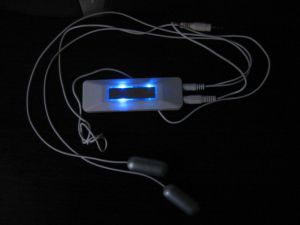
And of course, the LIGHTS! The LEDs flash to pattern or audio activation). My inner raver is totally PLUR puddling over this.
iBuzz and OhMiBod: Separated at Birth, literally
A few months ago, I pointed out that after taking apart the iBuzz and the OhMiBod, I found them to have almost the same exact hardware. The iBuzz people were happy to send me the explanation. Apparently both the iBuzz, OhMiBod, and a fair amount of other toys are all made by the same manufacturer in China. Even the Vibraexciter is made there. So they are, outside of some of the programming for the patterns and speed modes in the iBuzz, the EXACT SAME HARDWARE. However, as I ranted about muchly above, modularity > baseball bats.
Talk2Me
It's always the case that the thing that gets it (somewhat) right also isn't out yet. The Talk2Me Vibrator by SoftLabs uses not one, but TWO Band Filters.
The first toy will be a rather slickly made rabbit vibe, with treble being relayed in the clitoral stimulator and bass in the insertion part of the vibe. Not only that, it's wireless! They've actually built a small RF system that will allow you to stray from your music system and concentrate on the vibe. While it's going to be on the pricey side ($150), I certainly can't wait to get my hands on one of these. Even if it isn't particularly suited to my anatomy.
IGoGo: All in one! Only $500!
Update: The iGoGo is a TENS unit, not a vibrator. This should've been obvious by the pads, but I'm a lazy bastard who didn't read his own linked article.
What if you want to carry your music ON your TENS UNIT, though? Then there's the OSIM iGoGo! 128mb of memory, and only $500!
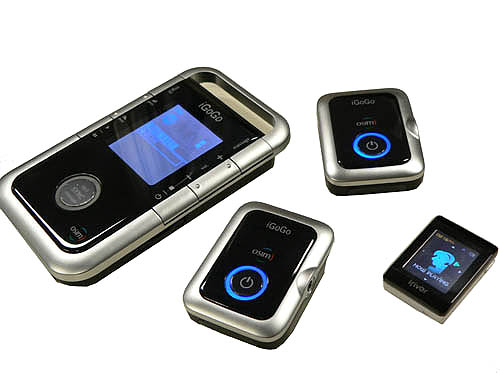
Now, I mean, there's not a lot to say here, except that it's a violently overpriced MP3 player that costs more than a nice manygig iPod plus 2 of the toys here. But really, with pictures like this:
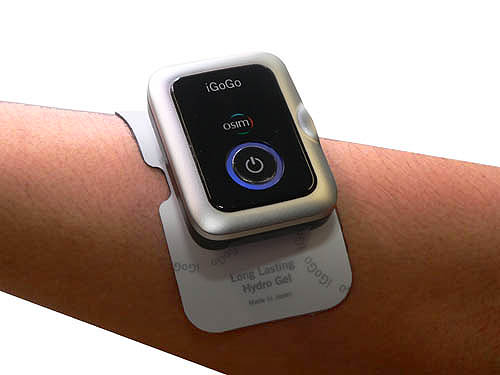
Wow. Electrostim MP3 player. That's.... I'm not real sure what that is.
DIY
In the time it took me to get around to finishing this article, something popped up that I wasn't aware of, which should make doing DIY audio projects a little easier. There's the LM4970.
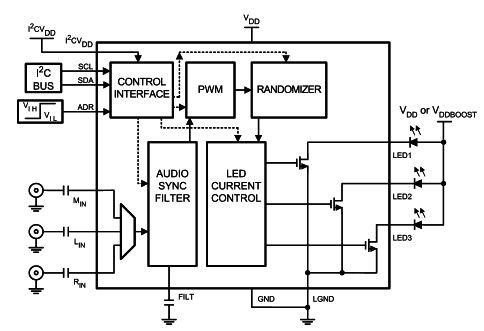
This chip is made for LED reaction on cell phones due to audio input. It takes 3 channels, all tuned for whatever band you please, and then translates that to what I believe is logic level PWM signals. So DIY could quickly move ahead of current product and have one MORE level of response. Of course, you could also wire up your own chip to do all sorts of crazy multiline filtering, but, well, whatever. This is easy. Assuming you can solder it.
Audio as Teledildonics Control Mechanism
So we've talked about solo play and distributed DJ lists, but why not create a remote control mechanism for audio toys through networks? All that needs to be done is to isolate the frequency response bands on each toy, document it, then create a program that can quickly make patterns inside those boundaries. Hook your toy into your sound card and you're ready to start playing.
While this sounds perfect up front, there's a few issues. First off, getting the toy connected correctly. You either need a multichannel card or a way to split right/left channels to have one running to the toy and the other to speakers/headphones (unless you don't mind running in silence). However, both of these are pretty common these days. Secondly, this is not the most precise of control mechanisms, even though you can send lossless audio across if you're using the audio channel only for control. However, since most people will want voice or music or something else, you can't get a good guarantee on what kind of control resolution you'll get. But, since we're using cheap, crappy motors most of the time anyways, this might not matter too much.
I plan on writing a quick test program that will work with the iBuzz and OhMiBod in this way, and will have it out sometime between now and forever.
Well, there you have it. An overview of all the audio toys currently available, and some new ideas on controlling them. So get out there and play! 'cause it very well could be 8 months before my next article.

